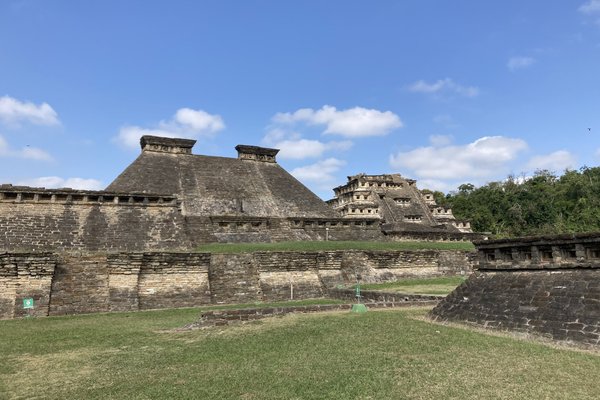Mexico
El Tajin
El Tajin, Pre-Hispanic City comprises an archaeological site along Mexico’s Gulf Coast that was at its height between 800 and 1200.
It is the best preserved and most thoroughly excavated pre-Hispanic town of its period, after Teotihuacan fell into decline and before the rise of the Aztecs. Numerous structures, including ball courts, temples, houses and public buildings, have been preserved. They are decorated with reliefs and paintings.
Community Perspective: This site has recently been through rough times during Hurricane Grace and COVID-19. Solivagant provides a view from before that era, while Shandos and Els had to make do with more limited access. Highlights include the Pyramid of the Niches and the panels on the side of the Juego de Pelota Sur depicting an imminent beheading.
Site Info
Official Information
- Full Name
- El Tajin, Pre-Hispanic City (ID: 631)
- Country
- Mexico
- Status
-
Inscribed 1992
Site history
History of El Tajin
- 1992: Inscribed
- Inscribed
- Type
- Cultural
- Criteria
- iii
- iv
Links
- UNESCO
- whc.unesco.org
- Official
-
- inah.gob.mx — Zona Arqueológica El Tajín y museo de sitio
All Links
UNESCO.org
- whc.unesco.org — whc.unesco.org/
Official Website
- inah.gob.mx — Zona Arqueológica El Tajín y museo de sitio
News Article
- Jan. 23, 2007 edition.cnn.com — Scientist: Pollution destroying pre-Aztec Mexican ruins
Community Information
- Community Category
- Archaeological site: Pre-Columbian
Travel Information
Recent Connections
-
No Map
-
Perfect Inscriptions
1992 -
Cacao
These fields not only produced staples …
Connections of El Tajin
- Individual People
-
-
Visited by Alexander von Humboldt on his travels
From Humboldt's "New Spain" vol II "In the northern part of the intendancy of Vera Cruz, west from the mouth of the Rio Tecolutla, at two leagues distance from the great Indian village of Papantla, we met with a pyramidal edifice of great antiquity. The pyramid of Papantla remained unknown to the first conquerors. It is situated in the midst of a thick forest, called Tajin in the Totonac language. ? The Indians concealed this monument, the object of an ancient veneration for centuries from the Spaniards; and it was only discovered accidentally by some hunters about thirty years ago."
-
- History
-
-
Aztec Empire
"The end for El Tajin came around 1200 when a marauding Aztec army of eagle and jaguar knights invaded and pillaged the area. In the aftermath of the battle, the city was completely abandoned. Fearing further attack, the population quickly surrendered to the Aztecs and became a subjugated people. The reign of the Aztecs over the dispersed descendants of El Tajin was so brutal that when the Spanish arrived on the shores of Veracruz in 1519, the Totonac and Huastec peoples joined with the conquistadors to exact revenge for their oppression." (Atlas Obscura) -
Archaeological 'Type Sites'
Classic Central Veracruz is focused upon north central Veracruz, where the type site of El Tajin is located (The New Encyclopaedia Britannica: Macropaedia - Page 10)See en.wikipedia.org
-
- World Heritage Process
- Human Activity
-
-
Slavery
"Slaves for service and sacrifice were ... sold" at the market at the Arroyo Plaza (wiki) -
Human Sacrifice
A relief panel from the south ballcourt of El Tajin, Veracruz showing two players holding down and extracting the heart of a third player. A skeletal figure rises from a pot on the left side. -
Writing systems
Various hieroglyphs, such as at the Southern Ballcourt: "Overlooking this scene is the death deity who rises from a vat of liquid, perhaps pulque. The glyphs above the deity identify it with the planet Venus." (wiki) -
Locations for playing sport
Pre-Columbian Ball court -
Cacao
These fields not only produced staples such as corn and beans but luxury items such as cacao. One of the panels at the Pyramid of the Niches shows a ceremony being held at a cacao tree. (wiki)
-
- Constructions
-
-
Pyramids
Its three plazas are surrounded on all sides by monumental structures in the form of pyramids (AB ev)
-
- WHS on Other Lists
-
-
UNESCO Intangible Cultural Heritage Lists
Location for regular performance by Totenacs of the Ritual Ceremony of the VoladoresSee www.unesco.org
-
- Timeline
-
-
Built in the 9th century
one phase of occupation lasting from 800 to 1200 (AB ev)
-
- Science and Technology
-
-
Archaeological potential
"It is believed that only half of El Tajin archeological site has been uncovered." (wiki) -
Astronomy and Astrology
The 'Pyramid of the Niches', a masterpiece of ancient Mexican and American architecture, reveals the astronomical and symbolic significance of the buildings. (official description)
-
News
- edition.cnn.com 01/23/2007
- Scientist: Pollution destroying pr…
Recent Visitors
Visitors of El Tajin
- Alberto Rodriguez Gutierrez
- Alejandro Lau
- Alexander Lehmann
- Artur Anuszewski
- Atila Ege
- brendairala
- Cheryl
- Christine
- Clyde
- czesioszpachelka
- Daniela Hohmann
- Dimitar Krastev
- Els Slots
- Erik Jelinek
- Fan Yibo
- Feldhase
- Francky D'Hoop
- GeorgeIng61
- headventure
- Iain Jackson
- Ivan Rucek
- Jarek Pokrzywnicki
- Javier Coro
- Jean Lecaillon
- Jens
- Joel on the Road
- Karito Vies
- Kasper
- Kurt Lauer
- Lara Adler
- Little Lauren Travels
- Lucas Del Puppo
- Luis Filipe Gaspar
- Malgorzata Kopczynska
- Martin
- Martina Rúčková
- Matthewsharris
- Michael Novins
- Miguel Marquez
- Mihai Dascalu
- Mikko
- Milan Jirasek
- MMM
- Nihal Ege
- Philipp Peterer
- Randi Thomsen
- Roger Ourset
- Roman Bruehwiler
- Ryan Gentry
- Shandos Cleaver
- Solivagant
- Svein Elias
- Szucs Tamas
- Thomas Buechler
- Tim Allen
- Vanessa Buechler
- Velvetlapis
- Westwards
- Wojciech Fedoruk
- Xiquinho Silva
- Zoë Sheng
Community Reviews
Show full reviews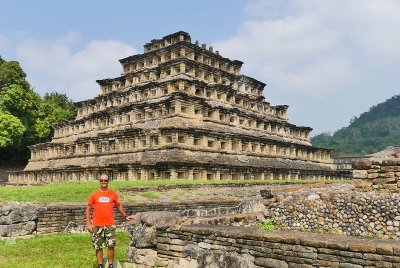
I visited El Tajin in March 2024 just before the Cumbre Tajin event and after a very near miss during COVID-19 times. All COVID restrictions have been lifted although the local museum on-site is closed more often than not due to the never-ending protests and strikes. Although this WHS does not receive the same amount of tourists as Teotihuacan or Chichen Itza, after renting a car in Mexico City the night before, I decided to rest at a motel just outside Papantla just a few kilometres away from the ruins to head there first thing in the morning. Surrounding the ruins are tobacco fields, banana plantations, apiaries and vanilla groves.
Just in front of the entrance to the ruins, every 30-60 minutes the voladores do their incredible ritual ceremony, itself a UNESCO intangible cultural heritage. Just after the museum and ticket booth, to the right is the brass UNESCO WHS inscription plaque. From there to the farthest point you can visit, it will take a good 20-30 minutes of non-stop walking, so even with very few stops for photos and to explore the site I would say that at least a couple of hours to half a day are required to view the whole ruins without any strict COVID restrictions in the year round rainforest climate. Keep in mind that El Tajin was named after the Totonac rain god for a reason, and all types of weather phenomena and natural disasters occur here.
El Tajin is one of …
Keep reading 0 comments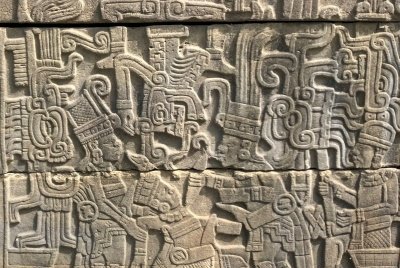
The reopening of El Tajin in mid-February prompted me to rearrange the final days of my 2022 Mexico / Central America trip. Instead of flying home from Cancun, I returned to Mexico City and took a 3.5h bus for an overnight stay in Poza Rica. From Poza Rica, a taxi took me to El Tajin: it is only 18 kilometers and it takes half an hour. I paid 200 pesos on the way up there, and 180 on the way back. Beforehand I did some desk research on buses/collectivos as well: they apparently leave from terminal El Parador, just south of the city center.
Only 500 visitors per day are now allowed (they’ve extended the numbers and opening hours a bit since Shandos visited), but that doesn't stop the souvenir sellers from unpacking all their stalls. They might as well be with 100 people as well.
I got there a little after the opening hour of 10 a.m., and there were already about 50 other visitors. Of the three parts the site consists of, Tajin Chico and the Group of Columns are not accessible at the moment. The small museum is also closed. The Tajin Complex, which can be visited, is the most monumental though.
With the exception of a few "normal" pyramids at the beginning of the site, the buildings with the niches that are so typical of El Tajin stand out. The niches are made of stacked flagstones. Why they were added to …
Keep reading 0 comments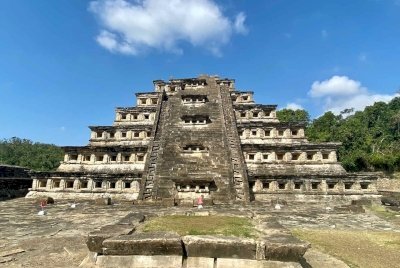
After a long closure due to Covid and a hurricane, reports came in early February 2022, while we were still in central Mexico, that El Tajin had re-opened. Not that you could tell from the government website, which still said it was temporarily closed. But reviews on Google Maps clearly showed recent visitors, as well as providing the information that the site was only open Monday to Friday, 10am to 4pm, with a maximum of 300 visitors per day.
When arriving at the site, the impact of the hurricane couldn't be seen, although whether due to the hurricane or Covid, the area of the site that you could visit was smaller than for previous visitors. After working out only one person per group could line up at the ticket office, we then followed a set circuit route around the site, ropes and signs restricting access. (Even the Unesco plaque was outside the roped path...)
After visiting numerous pre-Hispanic cities in central Mexico, the lush green grass and forested surrounds of El Tajin made for a picturesque change. The two highlights of our visit were the Pyramid of the Niches and the panels on the side of the Juego de Pelota Sur depicting an imminent beheading. However, access to Tajin Chico was completely restricted (maybe there was hurricane damage up there?) and in only an hour we wrapped up our visit.
To access El Tajin, we made a three day trip from Mexico City via public transport. It's …
Keep reading 0 comments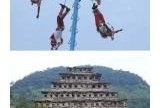
El Tajin may not be amongst the most famous of Mexico’s pre-Hispanic WHS but is well worth a visit unless you have surfeited on the others! Its location near the Gulf coast means that the vistas behind the inevitable pyramids are of tree clad hills rather than semi desert and the atmosphere is likely to be hot and steamy!
As you enter the site you will pass a high “Voladores Pole”. You have a chance here to see this spectacular ritual performed (photo 1) – you will be accosted and told when the next performance is (a “donation” is expected if you stay/return)! The pole here is metal and the event set up for tourists but it is better than nothing if you are not in a village where it is performed with a wooden pole as part of a local fiesta (We saw preparations such a performance over Semana Santa in the “Popocatapetl Missions” WHS of Tetela del Volcan). There are also performances across from the entrance to the National Anthropological Museum in Mexico DF.
El Tajin was the only site in Mexico where I was able to get my “over 60’s free entry” –everywhere else it has been limited to Mexican citizens and registered overseas residents. Otherwise entrance is 48 pesos (c US$4.5 in Mar 2008).
The site and museum take around 2-3hrs to visit at a fairly leisurely pace. The site’s “peak period” lasted between around 300-1100 AD and it was unused by the time Cortes landed …
Keep reading 0 comments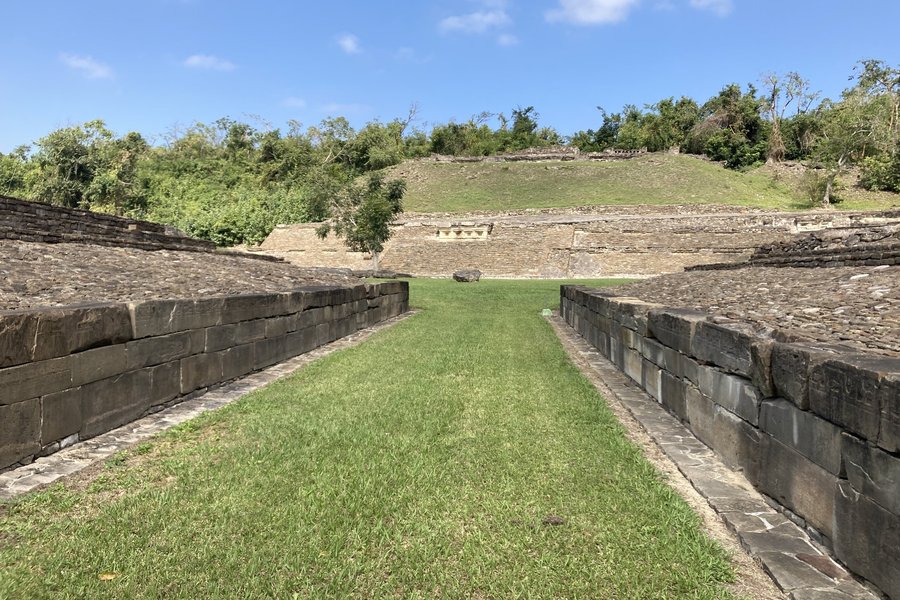
Arriving early on a Tuesday, I was nearly alone as the fog created an atmosphere of magic that increased as I moved through the site. The birds were still singing as I entered the ball court with base relief images. I continued to be astounded when I arrived at the pyramid of the niches. Walk up the hill and image a busy day centuries ago as you look down upon the religious site. Stay as long as possible before reentering the 21st century outside the gates.
Keep reading 0 comments
